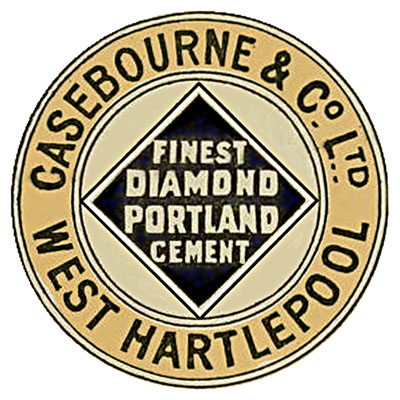
Casebourne's Diamond Brand.
Location:
- Grid reference: NZ51463125
- x=451460
- y=531250
- 54°40'25"N; 1°12'7"W
- Civil Parish: West Hartlepool, County Durham
Clinker manufacture operational: 1866-1912
Approximate total clinker production: 440,000 tonnes
Raw materials:
- Thames Chalk as ballast until 1901, after which commercial chalk was used.
- Tees Alluvium from Cowpen Bewley, County Durham 451200,525300 and local Boulder Clay from 451200,531300
Ownership:
- 1866-1882 Casebourne and Lucas
- 1882-1915 Casebourne and Co. Ltd
Sometimes known as Diamond Works or Longhill Works. Previously cement had been made 1862-1866 by Casebourne near the harbour at 451090,533370. The new site was perhaps selected because of the availability (in a small way) of clay. The plant was set up with two wet process bottle kilns, and expanded to four (120 t/week) by 1882, to ten (300 t/week) by 1891 and to 16 (480 t/week) in 1902. The plant was one of a few in the area that experimented with the use of slag in the 1890s, and through the agency of the Hartlepools Cement Co, they sold lime/slag cement as "genuine Portland cement". The site had run out of space by this stage, and it was ultimately replaced by the Billingham plant, remaining as top-up capacity after the Billingham kilns started in 1904, and closing when price competition forced Casebourne’s to settle for a smaller market. It had no local chalk tips, but moved material from the harbour by rail (2 km), first from stockpiled waste, then freshly-tipped ballast, then as commercial “return-load” cargoes. A warehouse was kept at the harbour to ship cement by sea, and this was probably the main mode of transport, although there were good rail links. On closure, the site was incorporated into the adjacent steel works. The latter is now long gone, and the site is a scrap yard.
Power supply
The entire plant was direct-driven by a 300 HP steam engine.
Rawmills
Only a washmill was used to make a thin slurry.
No rotary kilns were installed.
Sources::
- Primary Sources:
- V. Turley, Illustrated History of Casebourne’s Cement Plant 1862-1972, 1980, Teesside Archives U/CB/9, pp 2-4
- Ordnance Survey 1:2500 mapping
- Confirmatory Sources:
- Francis, p 229